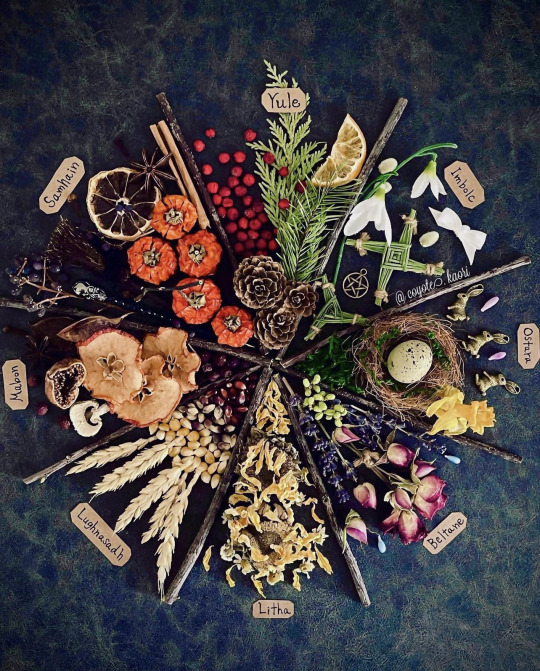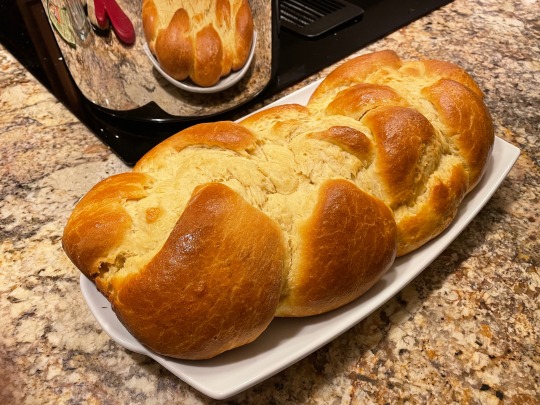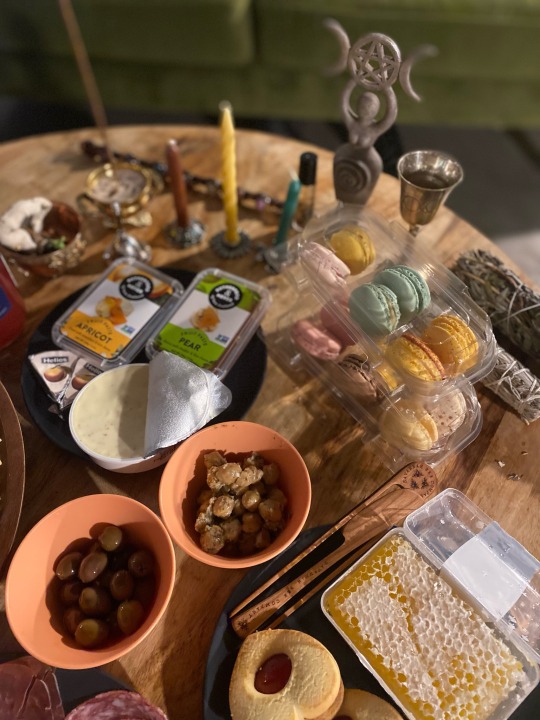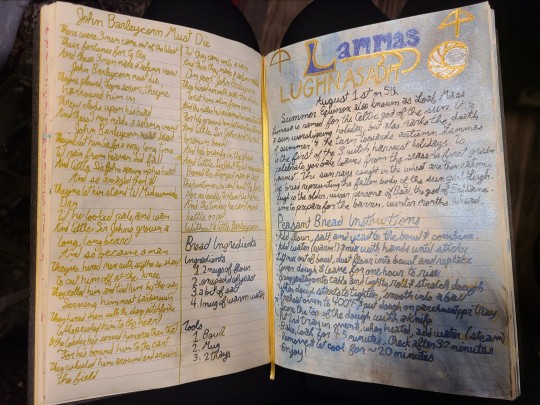#lughnassadh
Text

📷 Coyote.kaori
#wheel of the year#Samhain#mabon#imbolc#Ostara#Yule#litha#lammas#lughnassadh#beltaine#witchblr#witches of tumblr#witchcraft#wicca#pagan#witchy things#witchy#magick#green witch#baby witch#kitchen witch#witch altar#wiccan altar
2K notes
·
View notes
Text
Hope everyone enjoys their Tu B’av, Super moon, Lughnasadh, Lammas, or anything else you celebrate 🌙🌳🌾🍇

12 notes
·
View notes
Text
Happy Lughnasadh



Although today’s joyous first harvest, the grain harvest, tends to call for an earthier whole grain bread, I was feeling indulgent and made this braided brioche.
However you choose to celebrate this day, take some time to evaluate what you’re harvesting in your life right now and set your intentions on what you hope to manifest the rest of this year. Hopefully, you will see returns as we now approach the fall equinox in all its bounty.
4 notes
·
View notes
Text

2024 Wheel of the Year (Sabbats)
Pagan Wheel
Feb 2 – IMBOLC (also called Candlemas, Imbolg, and Saint Brigid’s Day) It is midway between the Winter Solstice and Spring Equinox. This sabbat reminds us that the light is growing stronger and that the harshness of winter will start to fade. To celebrate the growing light, many Pagans will light candles on this holiday.
Mar 19 – OSTARA /Spring Equinox: light and darkness are in perfect balance on this day. Moving forward, daylight will continue to grow as we head into Spring. It is a time to celebrate balance and the arrival of Spring. It represents new beginnings and the freshness of a new day. What’s past is in the past and past and it’s time to move forward.
May 1 – BELTANE (also known as May Day) (pronounced BELL-tain) This is an exciting and energetic holiday that celebrates sexuality, fertility, and all of the life that comes with Spring. It is a time of great joy and celebration! Feel the creative energy of the Universe. It is a time of renewal and rebirth … a time to grow as a person and reinvent yourself if you so desire.
June 20 – LITHA / Summer Solstice The Sun is at its maximum strength … it is the longest day of the year. This is a season of growth, fruitfulness, abundance, and strength. It’s a great night to perform spells for money, abundance, and financial security … and the strength to do what you need to do to be successful.
June 23 – Midsummer’s Eve: the night before Mid-Summer (June 24). It is considered a night of potent magick. Many Witches will be performing rituals and casting spells on this night. It is also a night when fairies roam the land. If you work with the fairy realm, this is an important night for you!
Aug 1 – LAMMAS (also known as Lughnassadh) the first harvest festival. It celebrates the first grains harvested for baking bread. Celebrate by baking or buying a loaf of bread and sharing it as a celebration.
Sept 22 – MABON / Fall Equinox: the light and darkness are in balance on this day. But it marks the change from the light half of the year to the dark half of the year. Moving forward the darkness will grow longer and the daylight will grow shorter. It is a celebration of the second harvest festival and is celebrated by feasting and visiting with family and friends.
Oct 31 – SAMHAIN (pronounced SAH-win) (as known as Halloween) This is the Witches’ New Year! The veil between worlds is thinnest and the dead are thought to return and visit. It is a night to communicate with the spirits, spirit guides, and ancestors. It is also a night to work with Tarot cards and Crystal Balls!
Samhain is also a time when we come to terms with death and are openly encouraged to let go of our fears of it. It is a time when we acknowledge the hard moments of life that we usually don’t think or talk about. If there are things we need to let go of, Samhain is a good time to release them!
Dec 21 – YULE / Winter Solstice: The real reason that this time of year was celebrated .. before christianity existed. We are halfway through the dark part of the year. The darkness is at its peak…moving forward the light begins to grow stronger and days become longer. You can see why the newly formed cult of christianity, which is what it was at the time, choose this time of year for the birth of christ…the light grows strong and brighter…the Sun is reborn. Yule traditions include burning a Yule log, kissing under mistletoe, and placing an evergreen tree in your home to represent the sustaining of life during the winter.
52 notes
·
View notes
Text
lammas! 🌼
-> what is it & why do i celebrate it?
─•~❉᯽❉~•─
lammas or lughnasad/lughnassadh is a pagan holiday and one of the sabbats that are celebrated through out the year’! 🌼
lammas occurs on the 1st August, which marks the midway point between the summer solstice & the fall equinox’! 🌎
although it’s still summer, this is the moment when the first hints of autumn begin to show. the first grains are ready to be harvested & the fruit from trees begin to drop 🌳.
it is important to give thanks for abundance of the past seasons as we celebrate, here are some other traditions that are followed too:
-> bread making 🍞
-> making corn dolls 🌽
-> alter re-decoration with the colours of summer and fall: yellow, orange, red, green & brown 💛🧡❤️💚🤎
-> dressing up in represented colours or interpreting them into your makeup 💄.
-> creating a feast filled with bread & vegetables 🥘.
-> spellwork surrounding abundance, protection & a happy home is usually worked well too! 🏡
remember each person celebrates & worships differently’! if you are happy with what you’re doing then that is all that matters’! <3
happy lammas & blessed be’! 🌼

gif not mine
sources of information:
-> link one
-> link two
#agere blog#age regression#agere community#safe agere#sfw age regression#sfw agere#sfw little community#sfw little blog#sfw little post#agere little#age dreaming#agere#age regressor#agere lifestyle#sfw interaction only#sfw little stuff#sfw blog#sfw regression#sfw caregiver#sfw furry#age regression caregiver#age re safe space#age re blog#pagan wicca#wicca altar#lammas#witchyreg#witchy regression
21 notes
·
View notes
Text





Happy Lughnassadh everyone! My wife and I have prepared a nice harvest fest to share with our good Lord and Lady. Hope all have a blessed next couple days and have a bountiful holiday!
#pagan#green witch#hearth witch#home witch#kitchen witch#paganism#eclectic pagan#lughnasadh#sabbat#fall#harvest#feast#food#holiday#charcuterie#meats#cheese#fruit#altar
74 notes
·
View notes
Text





Happy late lughnassadh!!
Bread:
Milk
Eggs
Self rising flour or leavening
Allspice!
Brown sugar
Pinch of black pepper
Pinch of salt
Bay leaf
Butter
Oven at 375 Fahrenheit
2/1 ratio of flour to egg/milk mix roughly (because you'll add more flour when kneading anyway) but you know. It should look and feel like dough and not batter
About a 3/1 ratio of flour to brown sugar, maybe a little more sugar. Depends how sweet you want it
Measure the allspice with your heart. Make the flour look speckledy
After all the ingredients are combined, knead it gently into a loaf
I baked it in a cast-iron frying pan, bottom coated in oil with a sheet of parchment. Because this is still the sunny part of the year I used a bay leaf in the bottom of the pan to symbolize Apollo <3
Drizzle/brush butter on the top
Bake it until a toothpick comes out clean. I... do not have enough chronological awareness, I'm sorry. Start with 20mins but it'll probably take longer!
It's very crumbly. I came up with this recipe while making the bread, so it can definitely be improved upon.
But it's also DELICIOUS. FKFLLFL. My mom and grandma both lowkey kinda freaked out (pos) about this bread. I did too.
Otherwise I fried some summer squash (in the same pan once the bread was done, use a little Tony chachere's but DONT OVERDO IT I LEARNED THat the hard way), lit my jackolantern for the first time this year, left some food out as a thank-you gift for the green man, and put some dolls in the window (one of which is a corn husk doll)
3 notes
·
View notes
Text
I have always hated my grimoire page for Lammas, but in honor of the holiday tomorrow, I thought I'd share it here.

Corn, wheat, and other grains are typically harvested around Lughnassadh. In agrarian cultures, this was the time to begin preparing for the barren winter months that lay ahead. Our ancestors cut, ground, and stored grain, canned fruit and vegetables, and brewed wine and beer in late summer. The old English song “John Barleycorn Must Die” describes the seasonal ritual of rendering grain into ale. Early Pagans sold their wares at harvest fairs and held athletic competitions at this time of the year. You can see this age-old tradition carried on today at country fairs throughout rural parts of the United States.
I'll be baking a loaf of rosemary bread to mark the holiday🍞🥳🔮
#witchcraft#witch#witchy#witchy woman#witches#witchblr#lammas#lughnasadh#wheel of the year#witchy things#witchy vibes#holiday#wiccan#pagan#grimoire#grimoire pages#book of shadows pages#book of shadows#witch shit#breadmaking
13 notes
·
View notes
Photo

Filled this space with sunflowers, for now - but I can’t see it changing much before Lughnassadh.
8 notes
·
View notes
Text
Wheel of the Year

The eightfold "Wheel of the Year" is the
seasonal cycle of Wiccan festivals.
On these eight days a ritual is performed to
realign ourselves with the Earth and it's cycles.
The Four Lesser Sabbats Spring Equinox (Ostara) March 21
Summer Solstice (Litha) June 21Fall Equinox (Mabon) September 21
Winter Solstice (Yule) December 21
The Four Greater Sabbats
Candlemas (Imbolc) February 2
Beltane (Walpurgis) May 1
Lammas (Lughnassadh) August 1
Halloween (Samhain) October 31
Winter Solstice: (Yule, December 20-23, varies on the standard calendar according to when the Solstice will occur astronomically) The name "Yule" derives from the Norse word for "wheel". This is the longest night of the year and the turning point when the days shall afterwards grow longer as winter begins its passage into the coming spring. It is the time when the Goddess (in her Divine Mother form) gives birth to the Sun God Child who shall eventually become her lover and father of the next child in the coming solar cycle. The Goddess, after giving birth, once more assumes her Virgin/Maiden form. Others celebrate the victory of the Lord of Light (or the Oak King) over the Lord of Darkness (or the Holly King) as the turning point from which the days will lengthen. Winter Solstice is a time for feasting and exchanging gifts. Traditional adornments are a Yule Log (usually of oak) and a combination of mistletoe and holly. For more information see: You Call it Christmas, We Call it Yule by Peg Aloi
Candlemas
(Imbolc, February 1 or 2, Many American Wiccans celebrate on the 2nd probably because of a confusion with Groundhog's Day) Originally celebrated on February 1st, this ancient Irish holiday was called Imbolc which means "in the belly". This festival is often called Brigid after the Celtic Fire Goddess Brigid, to whom this day is sacred. Her threefold nature rules smith craft, poetry/inspiration, and healing. Brigid's fire is a symbolic transformation offering healing, visions, and tempering. This is the time of Waxing Light. The infant Sun God born at Yule begins to grow and manifest His light as our days grow longer. It is a time of individuality, new beginnings, inspiration, returning light, purification, and chastity. Some traditions hold this to be the time of initiations. For more information see:
You Call it Groundhog Day, We Call it Imbolc
by Peg Aloi
Spring Equinox (Ostara, March 20-23, varies on the standard calendar according to when the Equinox will occur astronomically) The Germanic Goddess Ostara or Eostre (Goddess of the Dawn), after whom Easter is named, is the main deity of this holiday. The Spring Equinox defines the season where Spring reaches it's apex, halfway through its journey from Candlemas to Beltane. Night and day are in perfect balance, with the powers of light on the ascendancy. The God of light now wins a victory over his twin, the God of darkness. In the Welsh Mabinogion, this is the day on which the restored Llew takes his vengeance on Goronwy by piercing him with the sunlight spear. For Llew was restored/reborn at the Winter Solstice and is now well/old enough to vanquish his rival/twin and mate with his lover/mother. The coloring and giving of eggs at this time is a common pagan tradition. Eggs are clearly one of the most potent symbols of fertility, and spring is the season when animals begin to mate and flowers and trees pollinate and reproduce. In England and Northern Europe, eggs were often employed in folk magic when women wanted to be blessed with children. The great Mother Goddess, who returned to her Virgin/Maiden aspect at Candlemas, welcomes the young sun God's embraces and many wiccans believe that she conceives the new Sun Child now. (to be born 9 months later at the Winter Solstice). For more information see: You Call it Easter, We Call it Ostara by Peg Aloi
Beltane (Walpurgis, April 31 or May 1) This is the last of the three spring fertility festivals, the other two being Imbolc and Ostara. This festival and it's counterpart, Samhain, divide the year into it's two primary seasons - Winter and Summer. Whereas Samhain is about honoring death, Beltane is about honoring life. This festival heralds the beginning of summer and honors the joining of the God and the Goddess. Those wiccans who don't place the conception of the new Sun Child at Ostara place his conception here at Beltane. As such it is a common time for wiccan engagements and trial handfastings (a year and a day). Beltane translated means "fire of Bel" or "bright fire". Bel is known as the bright and shinning one, a Celtic Sun God. Beli is the father, protector, and the husband of the Mother Goddess. On Beltane eve the Celts would build two large Bel fires lit from the nine sacred woods. This is an invocation to the Sun God Bel to bring His blessings and protection to the tribe. The Bel fire is a sacred fire with healing and purifying powers. The fires further celebrate the return of life, fruitfulness to the earth and the burning away of winter. The ashes of the Beltane fires were smudged on faces and scattered in the fields. Household fires would be extinguished and re-lit with fresh fire from the Bel Fires. Another prominent part of Beltane is dancing around the Maypole. The Maypole is a tall phallic pole decorated with long brightly colored ribbons, leaves, flowers and wreaths. Dancing the Maypole during Beltane is magical experience as it is a conduit of energy, connecting all three worlds at a time when these gateways are more easily penetrable. As people gaily dance around and around the pole holding the brightly colored ribbons, the energy it raises is sent down into the earth's womb, bringing about Her full awakening and fruitfulness. For More information see: You Call it May Day, We Call it Beltane by Peg Aloi
Summer Solstice (Litha, June 21st or 24th) Directly opposite Yule on the Wheel of the Year, this is the Longest Day of the year and the time when we honor the Sun God as He ascends to His height of power before beginning His descent towards death and rebirth. The Mother Goddess is now heavily pregnant with the divine Sun Child representing the growing bounty on Earth. Couples in the Old Ways often didn’t get married until after they had a baby on the way, incidentally; it was necessary for farming couples to have children to help work the farm, and if a woman and man couldn’t prove themselves fertile before making a promise to stay together, it would not be a blessed marriage. That is why the Goddess is impregnated at Beltane but not actually married until Litha. In some Wiccan traditions, this is also the time that the Oak King (Lord of the summer) will be killed by the Holly King (Lord of the winter) turning the Wheel from the summer half to the winter half of the year. Midsummer Eve is the evening for harvesting your herbs for the coming year. It's also the best time to gather branches and make new wands and staffs. The herbs and flowers gathered this night are considered exceptionally potent. St John's wort, burdock, thorn, and nettle, harvested on Midsummer Eve are hung on doors and windows and placed around the home for protection. Couples who handfasted the year before at Beltane, tend to marry in a more formal handfasting at Midsummer or Lughnasadh. Divination on matters of love are especially powerful Midsummer's eve.
Lammas (Lughnassadh, August 1-2) Lughnasadh, which means "Lugh's assembly", is named for the Celtic deity Lugh who presides over the arts and sciences. Lughnasadh, in fact, has an even older name, Brón Trogain, which refers to the painful labour of childbirth. For at this time of year, the earth gives birth to her first fruits so that her children might live. Thus this is one of the four great celtic fire festivals, this particular one having it's emphasis on the first harvest. Now is the time when the powerful gods of the grain harvests are honored. One traditional Lammas custom was the construction of the kern-baby, corn dolly, or corn maiden. This figure, braided into a woman's form from the last harvested sheaf of grain, represented the Harvest Spirit. (In America, the tradition is continued in the making of corn husk dolls.) The doll would be saved until Spring, when it was ploughed into the field to consecrate the new planting and insure a good harvest. This is just the first of the Three Harvest Festivals (the second and third being Mabon and Samhain). This is a time of waiting, the Goddess now waits for the new Sun Child to be born and changes aspects from Mother to Crone as She oversees the harvest of the Earth.
Fall Equinox (Mabon, September 21) The autumnal equinox is commonly called "Mabon" after the Welsh god Mabon ap Modron, which means literally "son of mothers." Another name for this festival is from the Gaelic, Alban Elfed, or "Light of the Water." Now, as at Ostara, the days and nights are equal once again. This is the second of the three fall harvest festivals. Mabon marks the completion of the grain harvest begun during Lughnasadh. Celebrations revolve around the gathering of crops and thanksgiving for the abundances of the harvest, and rituals to insure the success of next year's harvest are characteristic during this harvest time. This is a time for reflection on the past year, a time to slow down a bit and ponder on the meaning of life and death. I suppose you could call this the Wiccan Thanksgiving. For more information see: You Call it Autumnal Equinox, We Call it Mabon by Peg Aloi
Halloween (Samhain, October 31) From the old Gaelic meaning "summer's end", this is third and last of the harvest festivals. Lying directly opposite of Beltain, this is one of the two great Celtic holidays which separates Summer from Winter. Many traditions consider this the eve of the New Year (as day begins with sundown, so the year begins with the first day of Winter). This is the best night for all forms of divination because the veil between the world of the seen and unseen is at it's thinnest allowing us to better see the unknown. This is the time to revere our ancestors and to say farewell to those that have passed this last year. The Crone Goddess, the ruler of the Otherworld, bids farewell to the Sun God as He passes over into death to face His rebirth at the upcoming Yule. As the Sun God journeys to the Underworld, He gathers unto Himself all those who have passed over to death since the previous Samhain to guide them on their way to the afterlife. For more information see: You Call it Halloween, We Call it Samhain by Peg Aloi
http://blessedbe.sugarbane.com/wheel.htm
5 notes
·
View notes
Text

@paperwitchco
#litha#ostara#beltane#yule#imbolc#manbon#lammas#lughnassadh#autumn equinox#spring eqinox#summer solstice#winter solstice#sabbat#wiccan sabbat#witches sabbat#wheel of the year#cakes and ale#witchblr#witches of tumblr#witchcraft#wicca#pagan#witchy#witchy things#baby witch#kitchen witch#kitchen witchcraft#hearth witch#hearth witchcraft
84 notes
·
View notes
Text
1 note
·
View note
Text
Blessings on this Lughnassadh

View On WordPress
0 notes
Photo

The Festival Sabbat of Lammas
Lughnassadh, Lugnasad August 1st/2nd
It is now high summer and the union of Sun and Earth, of God and Goddess, has produced the First Harvest. Lammas is the celebration of this first, Grain Harvest, a time for gathering in and giving thanks for abundance. We work with the cycle that Mabon or the Autumn Equinox is the Second Harvest of Fruit, and Samhain is the third and Final Harvest of Nuts and Berries.The word 'Lammas' is derived from 'loaf mass' and is indicative of how central and honoured is the first grain and the first loaf of the harvesting cycle.
https://www.goddessandgreenman.co.uk/lammas?fbclid=IwAR2C2z2QgzDG9cdEL7oUZ_Sxo2qK1u7DyuQ6OLA-8-9uzBFaZc7gK4ynG3g
56 notes
·
View notes

